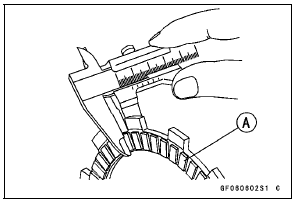

If any plates show signs of damage, or if they have worn past the service limit, replace them with new ones.

Friction Plate Thickness
Standard: 2.72  2.88 mm
2.88 mm
(0.107  0.113 in.)
0.113 in.)
Service Limit: 2.5 mm (0.098 in.)
 Spring Plate Free Play Adjustment
Spring Plate Free Play Adjustment Clutch Plate Warp Inspection
Clutch Plate Warp InspectionTire Air Pressure Inspection
Remove the air valve cap.
Measure the tire air pressure with an air pressure gauge
[A] when the tires are cold (that is, when the motorcycle
has not been ridden more than a mile during the past 3
hours).
Install the air valve cap.
Adjust the tire air pressure according to the specifi ...
Fuel Pressure Inspection
NOTE
Be sure the battery is fully charged.
Remove:
Fuel Tank Covers (see Fuel Tank Removal)
Fuel Tank Bolts (see Fuel Tank Removal)
Primary Fuel Hose (see Fuel Hose Replacement in the
Periodic Maintenance chapter)
Be sure to place a piece of cloth around the fuel outlet
pipe of the ...
Exploded View
13. Front Wheel Rotation Sensor
B: Apply brake fluid.
L: Apply a non-permanent locking agent.
R: Replacement Parts
S: Follow the specified tightening sequence.
Si: Apply silicone grease (ex. PBC grease).
10. Rear Wheel Rotation Sensor
B: Apply brake fluid.
G: Apply gr ...